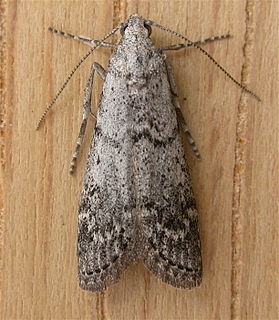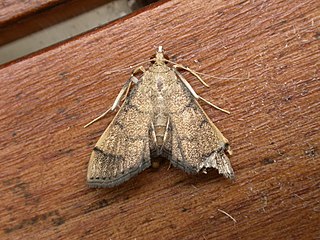
The Pyralidae, commonly called pyralid moths, snout moths or grass moths, are a family of Lepidoptera in the ditrysian superfamily Pyraloidea. In many classifications, the grass moths (Crambidae) are included in the Pyralidae as a subfamily, making the combined group one of the largest families in the Lepidoptera. The latest review by Eugene G. Munroe and Maria Alma Solis, in Kristensen (1999) retains the Crambidae as a full family of Pyraloidea.

The Pyraloidea are a moth superfamily containing about 16,000 described species worldwide, and probably at least as many more remain to be described. They are generally fairly small moths, and as such, they have been traditionally associated with the paraphyletic Microlepidoptera.

Heteromicta pachytera is a species of moth of the family Pyralidae. It is found in Australia, including Queensland, New South Wales, Victoria, South Australia and Tasmania.

Agrotera is a genus of snout moths in the subfamily Spilomelinae of the family Crambidae. It is the type genus of the tribe Agroterini and currently comprises 28 species distributed in the Afrotropical, Palearctic, Indomalayan and Australasian realm.
Anaclastis is a genus of moths of the family Crambidae. It contains only one species, Anaclastis apicistrigellus, which is found in Australia, where it has been recorded from Queensland and New South Wales.
Araeomorpha is a genus of moths of the family Crambidae.

Pyralis manihotalis is a moth of the family Pyralidae described by Achille Guenée in 1854.

The Phycitinae are a subfamily of snout moths. Even though the Pyralidae subfamilies are all quite diverse, Phycitinae stand out even by standards of their family: with over 600 genera considered valid and more than 4000 species placed here at present, they unite up more than three-quarters of living snout moth diversity. Together with the closely related Epipaschiinae, they are apparently the most advanced lineage of snout moths.

Glyphodes negatalis, the karanj defoliator, is a moth of the family Crambidae. The species was first described by Francis Walker in 1859. It has a wide range in the tropics, including South Africa, The Gambia, Mali, India, Sri Lanka, Hong Kong, Japan and eastern Australia.

Omiodes indicata, the bean-leaf webworm moth or soybean leaf folder, is a species of moth of the family Crambidae. It is found from Florida to Texas, the West Indies and Mexico to South America, Cameroon, the Comoros, the Democratic Republic of Congo, La Réunion, Madagascar, Mauritius, Nigeria, Saudi Arabia, the Seychelles, South Africa, India, Borneo and Australia (Queensland).

Pyrausta phoenicealis, the perilla leaf moth, is a moth of the family Crambidae described by Jacob Hübner in 1818. It is found worldwide, including the Americas, Africa, Australia and Asia.
Parapoynx epimochla is a moth in the family Crambidae. It was described by Turner in 1908. It is found in Australia, where it has been recorded from New South Wales.
Tawhitia pentadactylus is a moth in the family Crambidae. It was described by Zeller in 1863. It is found in Australia (Tasmania) and in New Zealand, where it has been recorded from South Island and the southern part of the North Island. The habitat consists of subalpine swamps.
Scoparia erythroneura is a moth in the family Crambidae. It was described by Turner in 1937. It is found in Australia, where it has been recorded from South Australia.
Pseudonoorda hemileuca is a moth in the family Crambidae. It was described by Turner in 1933. It is found in Australia, where it has been recorded from New South Wales and Queensland.
Tetracona amathealis is a snout moth in the subfamily Spilomelinae of the family Crambidae. It was described by Francis Walker in 1859 based on material collected at Moreton Bay in Queensland, Australia. It is found in New Guinea and Australia, where it has been recorded in Queensland, northern New South Wales and Western Australia. The species was formerly placed in the genus Agrotera, but in a recent taxonomic revision it was transferred back to the re-instated genus Tetracona, of which it is the type species.

Leucinodes cordalis, the poroporo fruit borer or eggfruit caterpillar, is a species of moth in the family Crambidae. It is found in New Zealand, Australia and Indonesia (Sulawesi). In Australia, it has been reported from Norfolk Island, the Northern Territory, Queensland, New South Wales, the Australian Capital Territory, Victoria, Tasmania and South Australia. The species was first described by Henry Doubleday in 1843.
Palpita limbata is a moth in the family Crambidae. It is found on Rennell Island and Guadalcanal, as well as in Australia, where it has been recorded from Queensland and New South Wales.
Sedenia atacta is a moth in the family Crambidae. It is found in Australia, where it has been recorded from South Australia.
Sedenia cervalis is a moth in the family Crambidae. It is found in Australia, where it has been recorded from South Australia and New South Wales.









